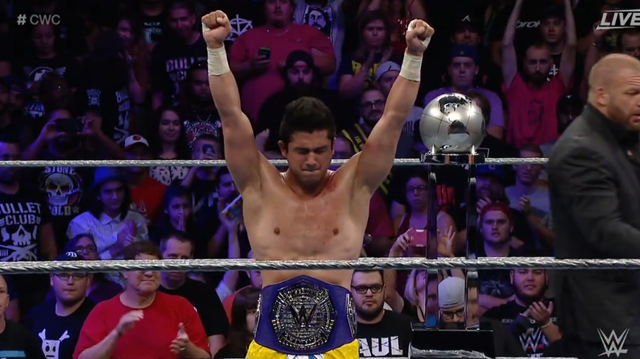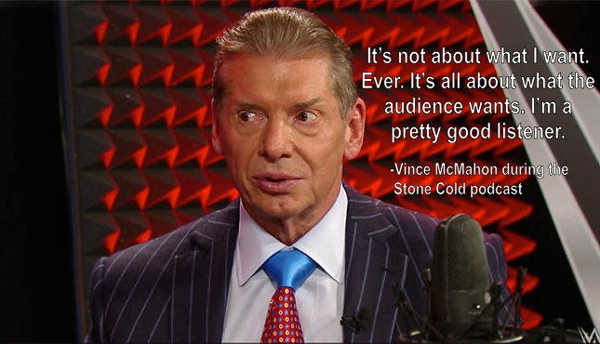wrestling / Columns
Cruiserweight Classic: Close as Pro Wrestling Comes to Sport

We knew as soon as we saw the Cruiserweight Classic and the bracketology previews that the WWE was shooting for a March Madness feel with its return to the sub-200 lb. weight class. What we didn’t know was whether it would work. Wrestling has often tried to mimic sports. Tournaments are a regular feature outside of the WWE. New Japan’s G1 Climax and Best of the Super Juniors are the gold standards. PWG’s Battle of Los Angeles and Chikara’s King of Trios are the two big stateside independent tournaments. ECWA’s Super 8 Tournament used to be in that class when Low Ki, the American Dragon (Daniel Bryan), Christopher Daniels, AJ Styles, Spanky (Brian Kendrick), Paul London, Austin Aries, Davey Richards, Charlie Haas, Petey Williams, Jerry Lynn, Austin Creed (Xavier Woods), Tommaso Ciampa, Adam Cole and some guy name Puma (T.J. Perkins under a mask) were among its main eventers, but it’s struggled to get that level of talent in recent years.
The WWE has an unspectacular history with tournaments. It’s done plenty of them, but never particularly well. WrestleMania IV crowned Macho Man Randy Savage as the WWE champion, which was fantastic to see and well deserved, but the tournament itself wasn’t great to watch. Austin 3:16 took place at the conclusion of the 1996 King of the Ring tournament. It’s one of the most iconic moments in wrestling, but the tournament itself was mostly garbage. More recently we saw a King of the Ring reboot in 2015, which was decent, but ultimately led nowhere for its winner Wade Barrett.

Perhaps the biggest reason for the WWE’s difficulty in staging tournaments is Vince McMahon’s sports entertainment bent. He prefers the cartoonish aspects of wrestling – promos, overbooking, ginned up feuds, overcoming impossible odds. The South Park take on the WWE – mostly dramatics, minimal rasslin’ – pretty much pigeonholed Vince’s view on things. He wants to sell a spectacle, and he’s made enough money doing it that you can’t say he’s wrong. Yet it doesn’t lend itself to great tournaments, which it tends to view as space fillers designed to reach a foregone conclusion most of the time.
Yet something is happening inside of Titan Towers these days. The company seems to be coming around to the notion that its product has gotten tired and way too predictable. We have the new roster split, designed to give a spotlight to more of the roster. Smackdown has finally gone live. We have numerous new (or dusted off) Sunday extravaganzas to make sure both Raw and Smackdown have big monthly cards. Most of all the company just did the Cruiserweight Classic with the idea that it would introduce a new division and new talents to its often tedious three-hour Raw broadcast. The E is trying new things in order to give its product a much-needed spark.
With the CWC it completely chucked the standard WWE format. We didn’t get loads of posturing leading up to the matches. We didn’t get clearly delineated good guys and bad guys. Instead it presented the tournament like it was a pure sport. Somewhere they realized that sports provides plenty of drama without the histrionics that surround you standard WWE match. Lorenzo Charles dunk at the buzzer to beat Phi Slamma Jamma, Kirk Gibson’s hobbling to the plate for pinch hit homer against the A’s in the 1998 World Series, Kevin Dyson coming up one yard short on the last play of Super Bowl XXXIV – all it was high drama and it came from nothing but pure competition.
I think most pro wrestling fans realize you can tell great stories in the ring through action and people will go crazy for it. The “this is awesome” chant has become universal when fans approve of the action in the ring. They’ll even cheer the losers for great efforts, and we saw that during the CWC with Cedric Alexander, Brian Kendrick and Kota Ibushi. It was refreshing to watch wrestling matches without the WWE trying to tell us who we should be rooting for. One of the great things about the tournament was I found myself rooting for T.J. Perkins early on because he was working a frenetic pace and seemed to be innovating on the fly. I did not realize he was that good. It was like someone finally gave the guy the chance to let loose with his full arsenal and he was going to be damned if he wasted the opportunity.
And here’s what we didn’t see: a ref bump, a run-in, a post-match staredown, a dusty finish, cheating to win, a rope shake, an alliance designed to “take over” the tournament, a heel turn, use of a foreign object or a match that devolved into a brawl. Didn’t need any of that. For 31 matches all we needed was two guys to walk down to the ring and show us how good they can be at pro wrestling. It was as close to sports as pro wrestling can get. They proved the central tenet of Vince Russo’s worldview wrong: people don’t just like wrestling, they love it.
Enhancing the whole package was the announce team. Mauro Ranallo is a consummate pro. His preparation for the tournament was superb. He called every move, knew where it came from and provided historical context. He made his bones calling professional boxing and MMA fights, but Ranallo has the tools to call any major sporting event and make the action palpable for the television viewing audience. He’s like the anti-Joe Buck, who often makes you want to change the channel in the middle of a good game.
And Daniel Bryan was the perfect color commentator. I actually had my doubts about how he’d do in that role, but he erased them all. First off, he’d been in the ring with a large number of the contestants, so he could provide insights into what they were doing. He did an outstanding job of explaining the physics and technique involved in the moves we were watching. He even managed to sell why a side headlock hurts so damn much for those who reflexively call it a boring rest hold. Yet, more than that, he provided the big picture. He put over just how complete the wrestlers in the CWC are at their craft, how these are the guys progressing the sport. He highlighted the qualitative difference in Kota Ibushi’s kicks, the technical artistry of the Zack Sabre Jr.-Drew Gulak match, the brutality of Lucha Libre submission holds and why it’s important to fly with the intent to punish your opponent. His appreciation for craft of pro wrestling shone through and made the viewer realize just how much of an athletic discipline pro wrestling can (and should) be.

In the end we got a fabulous underdog story with T.J. Perkins, who really was a revelation. TNA should be kicking itself that it never let him pull out all the stops in the X Division the way the WWE just did with the CWC. The guy is incredible. His speed and precision are super elite. Add him to the list with Kazuchika Okada and AJ Styles for TNA’s greatest mistakes. Gran Metalik also came off looking like a star. Blew my mind when he beat Akira Tozawa (who’s got Rock levels of ring charisma) and Sabre. Gave me a whole new appreciation for how versatile Lucha Libre can be. Really, everyone looked great.
The challenge now will be to carry what they’ve built forward, to have the sports aspect of the cruiserweight division remain intact amidst the bluster of your weekly Raw program. They might have to sedate Vince to pull it off, but the WWE did something innovative and excellent with the Cruiserweight Classic. It put the sports in front of the entertainment. Hopefully it reminded the WWE that the sport is entertaining all by itself.
More Trending Stories
- Backstage Update on WWE’s Plans for WrestleMania 41, Possible Move to March or May
- Tony Khan Addresses CM Punk’s Claims That He Paid for His Medical Care for Torn Triceps Injury
- Eric Bischoff Wouldn’t Put Money On Chances Of Vince McMahon Starting A New Wrestling Company
- Oklahoma Athletic Commission Gives AEW ‘Warning’ Over Nyla Rose Match, Rose Responds







